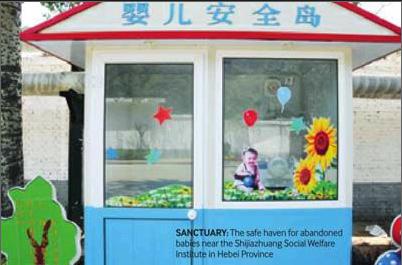Sheltered From the Storm
2014-02-10ByWangHairong
By+Wang+Hairong

On the morning of December 3, 2013, a new-born left the world that he had just arrived in while lying in a pile of trash outside in the cold winter of Beijings Tongzhou District.
The baby boy was discovered at around 7 a.m. the same day by passersby including a senior woman surnamed Sun.
Sun said that when she first saw the boy, he was naked and kicking his feet.
When emergency services arrived at around 7:40 a.m. in response to a report, they confirmed the boy had already passed away.
Local police reviewed surveillance videos near the scene and found that the baby was discarded at around 5 a.m. Unfortunately, lighting was not sufficient to identify the culprits face. Police are still investigating.
On December 5, 2013, at a news conference in Beijing, Dou Yupei, Vice Minister of Civil Affairs, mentioned the above case. He said that safe havens for abandoned babies should be set up because life is precious and childrens rights and interests should be a priority.
The proposed safe havens are temporary shelters that make sure that abandoned babies have a safe place to stay and can get timely help.
In China, it is illegal to abandon children. To escape punishment, the parents or guardians of unwanted children tend to leave them in places out of sight, and as a result, some babies may die or become handicapped because they are not found or treated in time.
According to Dou, setting up safe havens does not go against a policy of punishing those who abandon children.
Safe shelters
As early as in June 2011, Chinas first safe haven for abandoned babies was set up in Shijiazhuang, capital of northern Hebei Province. Dou said that the Ministry of Civil Affairs has invited scholars, child-welfare workers and representatives from social organizations to discuss the merit of such facilities, and participants recommended that they are built nationwide.
Set up by the Shijiazhuang Social Welfare Institute, the safe haven in Shijiazhuang is lo- cated close to its gate.
Although it covers an area of only a few square meters, the booth is equipped with a crib and bedding, an incubator and an air conditioner to keep babies warm and safe. An infrared detector can alert staff at the welfare institute a few minutes after a baby is left there, so that the baby can be taken care of quickly. Staff are also put on duty to check the booth regularly.
Since its establishment, the safe haven had received more than 180 babies as of the end of 2013, according to Shanghai Morning Post.endprint

The safe haven was first proposed by Han Jinhong, President of the Shijiazhuang Social Welfare Institute. Han said that before the shel-ter was built, nearly a dozen abandoned babies were discovered near the institute every year, most of whom were left in cartons or bags. They were exposed to the cold in winter and the heat in summer, and some were even attacked by cats and dogs, according to Han.
When Han learned about safe havens for abandoned babies set up in other countries, he planned to build a similar one.
“If we cannot stop people from abandoning babies, we can at least prevent the babies from suffering further,” Han said. “Almost all children sent to the safe haven are seriously ill or handicapped. They were put here because curing them seemed hopeless.”
Shi Tongtao, now nearly 2 years old, was spotted in the safe haven when she was 10 months old. She was found lying quietly in the crib, and her birthday was written on a note. Her skin was snow white and her hair was silver. Later, she was confirmed to have been born with albinism.
But not all babies are as lucky. The first baby picked up by the safe haven suffered from Downs Syndrome, and survived only nine days, leaving behind only a name and tiny footprints in his file.
Han said that the current procedure should be amended so that babies can be treated in time. Right now, babies arriving at the safe haven should first be examined by medical staff from the welfare institute, and only those who are seriously ill will be sent to designated hospitals. Han suggested that after reporting to the police, children should be directly sent to hospitals for a medical checkup, and get treated there if necessary.
Nationwide pilot
Now, safe havens for abandoned children have been set up in about a dozen cities in Hebei. At the request of the Ministry of Civil Affairs, the practice has also begun trials at other places in the country.
On December 4, 2013, a shelter was open in Guiyang, capital of southwestern Guizhou Province. Five days later, the first abandoned baby appeared in the safe haven. She was put on the crib, together with two bags of clothes and some money, according to a report by local paper Guiyang Evening News. The girl was about one month old, and was not in good health. She was sent to hospital and diagnosed with a serious lung infection and heart abnormalities.endprint
The Social and Children Welfare Institute in Nanjing, capital of eastern Jiangsu Province, established a baby shelter on December 10, 2013. Just hours after it was put into operation, it received its first baby, a boy less than one month old. No discernible abnormalities were found in the boy, so he was admitted into the welfare institute for further examination and observation. The next morning, the boy was found sick and sent to hospital, local paper Modern Express reported.
Shenzhen, in southern Chinas Guangdong Province, is planning to open its first shelter for abandoned children later this year, according to Tang Rongsheng, Director of the Shenzhen Welfare Center.
Statistics from the Shenzhen Welfare Center show that from its inception in 1992 to June 2013, the center received 3,571 abandoned children, averaging 107 per year.
However, the baby shelters have been greeted with both praise and criticism.
A netizen with the screen name Luoxue Tiantong said that having shelters is a good thing since they can help abandoned children live better.
Yet some worry that these facilities will encourage desperate parents to abandon their babies, as it presents an easy way out of their troubles.
The same concern haunted Han when launching the safe haven in Shijiazhuang, but he admitted that these worries might be unwarranted.
Han said that in the first half of 2012, the number of children received in the safe haven increased remarkably after more than 30 media outlets reported on the facility. However, this did not lead to an increase in the number of abandoned children, for those who would have been abandoned elsewhere have now been brought to the safe haven, he explained.
When parents came back to retrieve their abandoned babies, the welfare institute discovered that some babies were from other provinces, such as Liaoning, Jiangxi, Hunan and Shaanxi. After the safe haven was set up, his institute has seen four or five families reunited every year, Han added.
As more and more cities in Hebei set up safe havens in the latter half of 2012, the number of babies sent to the Shijiazhuang Social Welfare Institute dropped to around 10 per month in 2013, according to Han.
Netizen Nanwai Jiliang said that babies are abandoned either because their families cannot afford to raise them or because of birth defects; so the solution is to strengthen prenatal and postnatal examination and care, and give poor families allowances to help them raise their children.endprint
